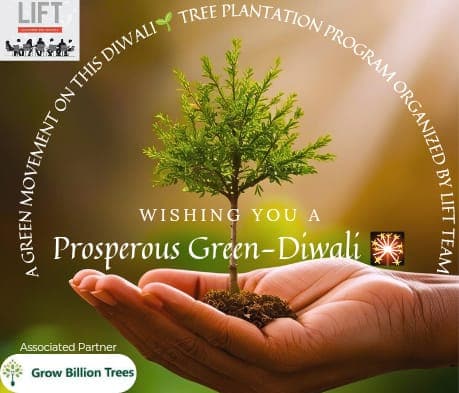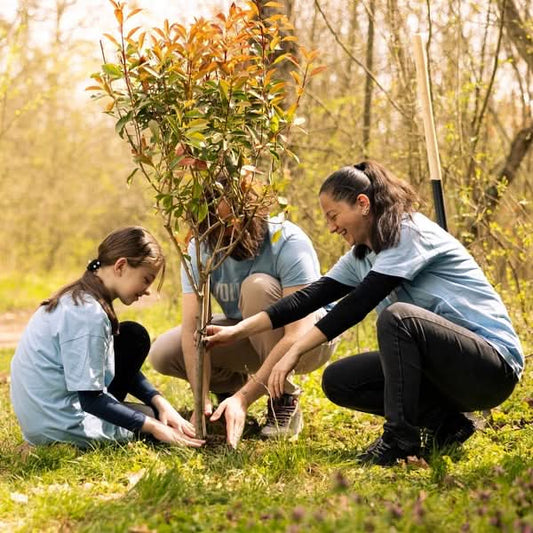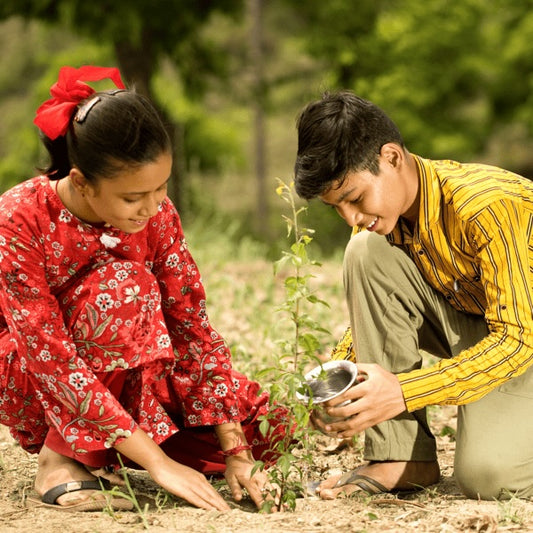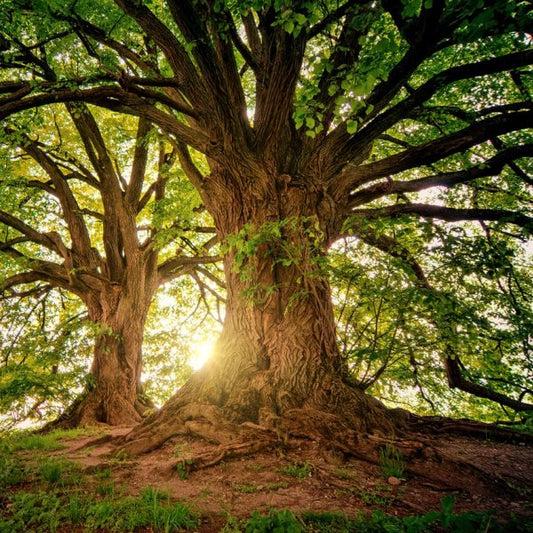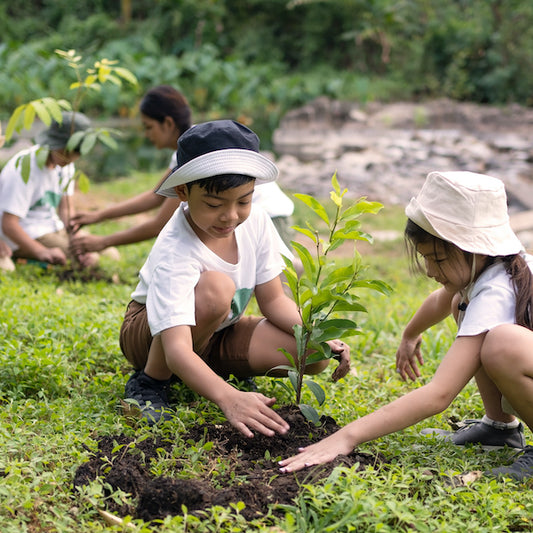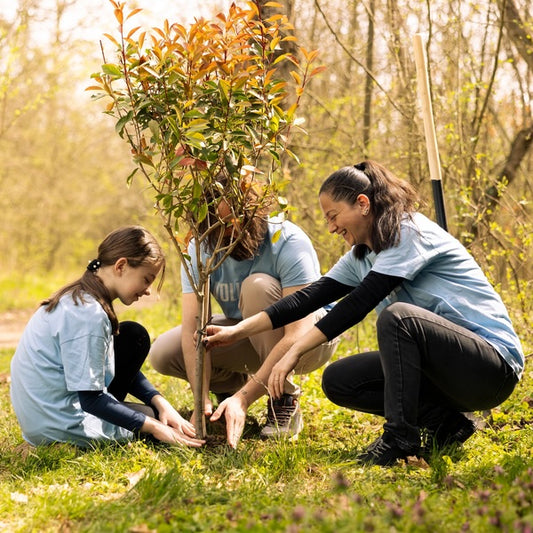Care for Earth in Action: Himalaya’s Verified Path to Environmental Re
Himalaya Wellness Company, a global leader in herbal healthcare and personal care, has launched a strategic tree plantation initiative rooted in the a Read more
Care for Earth in Action: Himalaya’s Verified Path to Environmental Resilience in Matali
Himalaya Wellness Company, a global leader in herbal healthcare and personal care, has launched a strategic tree plantation initiative rooted in the agroforest concept to reinforce its long-standing commitment to biodiversity and environmental sustainability. This initiative aligns with Himalaya’s mission of “Care for Life” by integrating ecological stewardship with community empowerment.
The primary objective of this initiative is to support Himalaya’s biodiversity vision through comprehensive field-level verification and evaluation. The effort encompasses:
-
Nursery Verification: A thorough assessment of the availability and quality of 23 key plant species critical to Himalaya’s product and sustainability goals.
-
Existing Sites Evaluation: Review of current plantation models managed by Grow Billion Trees across the district, including Community Forests, Agroforestry plots, and Poshan Vatikas, to evaluate performance and community impact.
-
Village-Level Assessment: On-ground inspections of both Panchayat-owned and privately held farmland to determine the feasibility, ecological readiness, and community alignment for future plantations.
This multi-pronged initiative not only enhances Himalaya’s sustainable sourcing practices but also contributes to climate resilience, rural livelihoods, and habitat restoration. By combining traditional Ayurvedic wisdom with scientific evaluation, the project ensures that every sapling planted nurtures not just the land but the people and ecosystems it supports.
Project Planning & Execution
No of Trees: 5010
Plantation Location: Village Matali, Tehsil Rajpur, Dist. Barwani, Madhya Pradesh 451447
Beneficiaries Details
-
Target Population: Employees, stakeholders, and local community members of Matali
-
Age Group: All age groups focus on adults to seniors
-
Gender: Inclusive of all genders
- Social & Economic Status: Open to all social and economic backgrounds, emphasizing community involvement
Planting Methodology and Its Advantages
Community Forest: A community forest is a carefully planned green space where trees, shrubs, and vegetation are planted to support local ecosystems, enhance biodiversity, and provide social and economic benefits to nearby communities. It plays a crucial role in environmental conservation by improving air quality, preventing soil erosion, and increasing water retention. Additionally, community forests contribute to climate change mitigation by absorbing carbon dioxide while offering shade, fruit, and other resources to local populations. By fostering a strong connection between people and nature, community forests promote sustainable living and create long-term ecological and social benefits.
Advantages of Community Forest
-
Biodiversity and Wildlife Conservation: By creating natural habitats, community forests support diverse flora and fauna, promoting ecological balance and enhancing biodiversity in the region.
-
Climate Change Mitigation: Community forests play a vital role in capturing and storing carbon dioxide, mitigating climate change, and improving resilience against extreme weather conditions, such as droughts and storms.
-
Cooling Effect: Community forests help regulate local temperatures by providing shade and facilitating transpiration, reducing heat stress in rural and semi-urban areas. This natural cooling effect helps create a more comfortable environment for surrounding communities.
-
Improved Air Quality: Trees in community forests absorb pollutants like carbon dioxide, sulfur dioxide, and particulate matter, leading to cleaner air and reducing respiratory issues for nearby residents.
-
Water and Soil Conservation: Community forests play a vital role in soil conservation and water management by stabilizing soil with extensive root systems, preventing erosion from wind and heavy rainfall, and reducing land degradation.
-
Resilience to Natural Disasters: Properly managed community forests can help reduce the impact of natural disasters, such as floods and landslides, by stabilizing the land and acting as natural barriers.
-
Livelihood and Economic Benefits: Community forests provide valuable resources such as fruits, timber, medicinal plants, and fodder, supporting local economies and offering additional income opportunities for farmers and rural communities.
-
Educational Value: The community forest acts as a living classroom, offering insights into sustainable land management practices and environmental conservation. It provides opportunities for local communities, schools, and organizations to learn about biodiversity, water conservation, and the importance of ecological balance, fostering a culture of environmental awareness.
- Cultural and Social Benefits: Community forests serve as spaces for social gatherings, traditional ceremonies, and educational initiatives, strengthening community bonds and fostering environmental stewardship among local populations.
Conclusion Elements
Impact
Indirect Impact
Community Impact
-
Improved Public Health: By enhancing air quality and providing shade, the community forest contributes to better public health. Green spaces encourage outdoor activities, reducing stress, promoting mental well-being, and lowering the risk of respiratory diseases.
-
Economic Benefit: The plantation of fruit-bearing and indigenous trees provides long-term economic benefits to the local community by generating opportunities for sustainable livelihoods, improving soil quality for agriculture, and enhancing local biodiversity, which supports ecotourism and related activities.
-
Environmental Awareness: Engaging employees and local communities in tree plantations raises awareness about environmental conservation and fosters sustainable habits in everyday life.
-
Employee Morale: The initiative instilled a sense of pride and collective responsibility among employees, strengthening team bonds and reinforcing their alignment with the company’s values.
-
Inspiration for Change: The success of this initiative has motivated other organizations and local communities to take up similar environmental efforts, promoting a culture of sustainability.
-
Cultural Shift: By actively participating in reforestation efforts, employees and community members developed a long-term commitment to environmental stewardship, advocating for green practices in their personal and professional lives.
- Higher Property Values: Proximity to green spaces often leads to higher real estate values, benefiting local economies.
Environmental Impact
-
Carbon Sequestration: The trees planted through Himalaya Wellness Company’s community forest act as carbon sinks, absorbing carbon dioxide and contributing to climate change mitigation.
-
Soil Health Improvement: The initiative improves soil quality by adding organic matter, enhancing fertility, and supporting the growth of native vegetation.
-
Erosion Prevention: The deep root systems of planted trees help stabilize soil, preventing erosion caused by wind and water, thereby protecting nearby lands and infrastructure.
-
Biodiversity Conservation: By creating a diverse green space, the project provides habitats for various species, including birds, pollinators, and beneficial insects, strengthening the local ecosystem.
-
Water Cycle Regulation: Trees aid in groundwater recharge by improving water retention in the soil, reducing surface runoff, and contributing to a more balanced and sustainable water cycle.
- Microclimate Regulation: The plantation helps moderate temperature fluctuations, increase humidity, and reduce wind speeds, fostering a favorable environment for both the community and local wildlife.
Achievements
SDG Goals Achieved through Community Forest
-
SDG 1: No Poverty- Himalaya Wellness Company’s Community Forest Initiative contributes to SDG 1: No Poverty by enhancing local livelihoods through sustainable practices. The plantation of medicinal and native trees in Matali, Madhya Pradesh, supports economic opportunities for nearby communities by providing resources such as fruits, fodder, and medicinal plants.
-
SDG 2: Zero Hunger- Fruit-bearing trees contribute to food security by providing nutritious resources and supporting efforts to combat hunger and malnutrition in underserved areas.
-
SDG 3: Good Health and Well-being- Trees improve air quality, reduce pollution-related diseases, and promote mental well-being by creating green spaces for relaxation and physical activity.
-
SDG 4: Quality Education- The Himalaya Wellness Company initiative fosters environmental awareness and lifelong learning, educating employees and communities on the importance of sustainability and ecological balance.
-
SDG 6: Clean Water and Sanitation- Trees enhance groundwater recharge, prevent soil erosion, and reduce water pollution, ensuring cleaner and more sustainable water resources for communities.
-
SDG 8: Decent Work and Economic Growth- Green job creation through afforestation activities supports economic growth, offering employment in site preparation, sapling maintenance, and forest management.
-
SDG 9: Industry, Innovation, and Infrastructure- Sustainable infrastructure development through green initiatives like community forests promotes innovative solutions to environmental challenges, building long-term resilience.
-
SDG 11: Sustainable Cities and Communities- The Himalaya Wellness Company Community forests improve urban livability by reducing pollution, mitigating the heat island effect, and providing green spaces for recreation and well-being.
-
SDG 12: Responsible Consumption and Production- Sustainable resource management through tree plantations encourages responsible consumption, ensuring the long-term availability of renewable resources like fruits and timber.
-
SDG 13: Climate Action- Trees act as carbon sinks, reducing greenhouse gas emissions and contributing to climate change mitigation while promoting environmental awareness and conservation.
-
SDG 15: Life on Land- The Himalaya Wellness Company initiative supports biodiversity, prevents land degradation, and combats deforestation by restoring ecosystems and providing habitats for various species.
- SDG 17: Partnerships for the Goal- Himalaya Wellness Company's collaboration with Grow Billion Trees enhances collective action for sustainability, uniting employees, communities, and environmental stakeholders for a greener future.
ESG Achieved through Community Forest
-
Environmental Impact: Himalaya Wellness Company’s community forest initiative plays a pivotal role in environmental sustainability by promoting carbon sequestration, biodiversity restoration, and natural resource conservation. By planting native and Ayurvedic species such as neem, tulsi, and ashwagandha, the initiative mitigates climate change, enhances ecosystem resilience, and supports habitat restoration. It also helps prevent soil erosion, improves groundwater recharge, and contributes to cleaner air and a greener landscape. Through scientifically guided plantation planning and sustainable land management, Himalaya ensures lasting ecological benefits aligned with its core philosophy of "Care for Earth."
-
Social Impact: Himalaya’s community forest efforts bring profound social value by supporting sustainable livelihoods, improving nutrition through fruit-bearing trees, and enhancing rural income diversification. The initiative enables farmers and rural communities to boost productivity and economic resilience by integrating tree cover with existing land use. It fosters food security, creates local employment, and improves community well-being through green spaces and cleaner environments. Additionally, Himalaya engages local stakeholders via village-level assessments and awareness programs, equipping them with knowledge and skills for sustainable environmental practices, thereby promoting inclusive growth and long-term social upliftment.
-
Governance Impact: Himalaya Wellness Company demonstrates strong ESG governance by embedding sustainability and ethical practices into its business strategy. The community forest initiative reflects a transparent and responsible approach to environmental stewardship, involving verified nursery practices, scientific evaluations, and collaborative planning with Grow Billion Trees and local communities. This initiative is part of Himalaya’s broader commitment to corporate responsibility, aligning operational goals with ecological and social impact. By prioritizing accountability and long-term value creation, Himalaya showcases leadership in sustainable governance and community-driven impact.
Building Communities
Himalaya's community forest initiative goes beyond tree plantation; it strengthens rural communities by fostering collaborations and creating sustainable livelihoods. By integrating environmental stewardship with social impact, the project nurtures a sense of shared responsibility, driving long-term benefits for both people and the planet.
-
Empowering Farmers: Himalaya’s community forest initiative encouraged active local participation, equipping individuals with knowledge about sustainable forestry and eco-conscious practices. By involving farmers and villagers directly in tree plantation and care, the initiative nurtured a strong connection between people and the land. This hands-on approach fostered long-term environmental stewardship and empowered communities to take charge of their green future.
-
Fostering Partnerships: The collaboration between Himalaya Wellness Company, Grow Billion Trees, and local stakeholders highlighted the strength of partnerships in achieving meaningful impact. This multi-stakeholder model brought together corporate responsibility, environmental expertise, and community involvement to drive both ecological restoration and social upliftment, turning shared vision into rooted action.
-
Creating a Ripple Effect: As communities experienced the tangible benefits of richer biodiversity, improved microclimates, and revitalized green spaces, the initiative inspired broader participation. What began as a focused project evolved into a larger movement for environmental care, encouraging neighboring areas to embrace community forestry and sparking a collective drive toward sustainable living.
This initiative proved that environmental sustainability thrives when rooted in community effort. It’s not just about planting trees; it’s about planting hope, collaboration, and a shared vision for a greener tomorrow.
Commitment by Grow Billion Trees
-
Ensuring Tree Survivability: GBT prioritizes native species, continuous monitoring, and soil health improvement using organic fertilizers. These efforts ensure sustainable growth and benefit the farmers and communities.
-
Transparency & Accountability: GBT provides detailed reports on tree growth, survival rates, and carbon benefits, using geo-fencing and regular updates to maintain transparency and effectiveness.
-
Sustainable Plantation Efforts: GBT implements projects that balance environmental, social, and economic goals, addressing urban heat islands and degraded farmlands. These efforts promote ecological balance, livelihoods, and long-term climate resilience.
-
Enhancing Ecosystem Health: By selecting native species and creating diverse habitats, GBT enhances biodiversity and ecosystem resilience, ensuring long-term ecological health and supporting wildlife.
-
Long-Term Impact: GBT’s initiatives tackle environmental challenges, enhance rural livelihoods, foster climate resilience, and promote sustainable development while reducing carbon footprints.
Acknowledgment
We at Grow Billion Trees extend our heartfelt gratitude to everyone who contributed to the success of our community forest initiative in Matali, Barwani, Madhya Pradesh. This project, which beautifully weaves together environmental restoration and community upliftment, stands as a shining example of what collaborative efforts can achieve.
To Himalaya Wellness Company: We deeply appreciate your unwavering commitment to sustainability and holistic well-being. Your support for this community forest initiative has not only helped rejuvenate green spaces but has also strengthened rural communities through meaningful engagement and livelihood opportunities. By integrating native and Ayurvedic species into the landscape, you have aligned ecological restoration with your philosophy of "Care for Earth," setting a benchmark in responsible corporate stewardship. This initiative is a living testament to your vision of nurturing both people and the planet.
To Our Ground Partners and Volunteers: Your dedication, expertise, and hands-on efforts have brought this vision to life. From preparing the land to planting and nurturing saplings, your contributions have been vital in restoring biodiversity, promoting environmental awareness, and creating a sustainable impact. Your actions inspire communities to take ownership of their environment and continue this green legacy for generations to come.
Thank you for your unwavering commitment and support.
Closing Remarks
We are proud to have partnered with Himalaya Wellness Company on their inspiring journey of environmental stewardship through the Community Forest Initiative in village Matali, Barwani, Madhya Pradesh. Rooted in the company’s core philosophy of "Care for Earth," this initiative reflects a deep commitment to nurturing both nature and communities.
By planting 5,010 trees, this project has not only revitalized the local ecosystem but also empowered rural communities through sustainable green practices. The thoughtfully selected native and Ayurvedic species will contribute to long-term biodiversity enhancement, carbon sequestration, and improved soil and water health, ensuring that the benefits of this initiative endure well into the future.
This collaboration has reinforced the power of collective action in driving environmental and social change. It stands as a living example of how responsible corporate practices can create harmony between ecological restoration and community well-being.
As we look ahead, we remain committed to growing this impact and inspiring more like-minded organizations to join the movement for a greener, more resilient planet. Together, let us continue to plant not just trees, but hope for today and generations to come.
A heartfelt thank you to everyone who made this vision a reality.
Trees for Corporates
Trending
Most Popular
1. Sustainable Tree Plantation
1. Sustainable Tree Plantation
When Himalaya Wellness Company says "Care for Earth," they don’t just mean applying a neem face pack and calling it a day. Their commitment comes with roots—literally! Through sustainable tree plantation in community forests, they’re giving back to Mother Nature, one Ayurvedic species at a time. This isn’t just about throwing saplings into the soil and hoping for the best. It’s about strategic, sustainable planting—where trees are chosen for their long-term environmental, medicinal, and economic benefits.
When Himalaya Wellness Company says "Care for Earth," they don’t just mean applying a neem face pack and calling it a day. Their commitment comes with roots—literally! Through sustainable tree plantation in community forests, they’re giving back to Mother Nature, one Ayurvedic species at a time. This isn’t just about throwing saplings into the soil and hoping for the best. It’s about strategic, sustainable planting—where trees are chosen for their long-term environmental, medicinal, and economic benefits.
Sustainable tree plantation ensures carbon sequestration, improves biodiversity, and supports the local ecosystem. Add a few tulsi and ashwagandha plants in the mix and you’re not just planting trees—you’re growing wellness. Himalaya’s community forest initiative is proof that sustainable growth isn't just a corporate buzzword; it's a green revolution with roots in rural empowerment and foliage that whispers "we care."
Sustainable tree plantation ensures carbon sequestration, improves biodiversity, and supports the local ecosystem. Add a few tulsi and ashwagandha plants in the mix and you’re not just planting trees—you’re growing wellness. Himalaya’s community forest initiative is proof that sustainable growth isn't just a corporate buzzword; it's a green revolution with roots in rural empowerment and foliage that whispers "we care."
Let’s just say, while others are busy growing spreadsheets, Himalaya is growing forests—with purpose.
Let’s just say, while others are busy growing spreadsheets, Himalaya is growing forests—with purpose.
2. Ayurvedic Species Plantation
2. Ayurvedic Species Plantation
Neem, tulsi, ashwagandha—sounds like the ingredients list of a wellness bestseller, right? Well, in Himalaya Wellness Company's community forest initiative, these Ayurvedic superstars are the VIPs of the plantation party. Not only are they packed with ancient healing wisdom, but they also pack a punch when it comes to ecosystem health.
Neem, tulsi, ashwagandha—sounds like the ingredients list of a wellness bestseller, right? Well, in Himalaya Wellness Company's community forest initiative, these Ayurvedic superstars are the VIPs of the plantation party. Not only are they packed with ancient healing wisdom, but they also pack a punch when it comes to ecosystem health.
Planting Ayurvedic species isn't just smart—it's brilliant. These plants are naturally pest-resistant, improve soil health, and support biodiversity. Plus, they smell divine (bonus!). Himalaya’s decision to incorporate Ayurvedic species into their tree plantation isn’t just poetic, it’s purposeful. They’re restoring green cover while honoring India’s herbal heritage—a double win for the planet and for wellness lovers.
Planting Ayurvedic species isn't just smart—it's brilliant. These plants are naturally pest-resistant, improve soil health, and support biodiversity. Plus, they smell divine (bonus!). Himalaya’s decision to incorporate Ayurvedic species into their tree plantation isn’t just poetic, it’s purposeful. They’re restoring green cover while honoring India’s herbal heritage—a double win for the planet and for wellness lovers.
So, the next time you sip tulsi tea or apply a neem-based balm, just remember
somewhere in Madhya Pradesh, a tree is quietly growing to keep you glowing.
3. Community Forest Development
3. Community Forest Development
Move over concrete jungles, community forests are the real urban upgrade. Thanks to Himalaya Wellness Company, the villagers of Matali in Barwani, Madhya Pradesh, aren’t just surrounded by trees—they’re surrounded by opportunity.
Move over concrete jungles, community forests are the real urban upgrade. Thanks to Himalaya Wellness Company, the villagers of Matali in Barwani, Madhya Pradesh, aren’t just surrounded by trees—they’re surrounded by opportunity.
Community forest development goes beyond green—it’s about creating shared spaces that boost biodiversity and bring people together. With 5010 trees rooted in local soil, the project breathes life into barren landscapes and into the local economy. Locals aren't just passive observers; they’re the driving force—planting, nurturing, and learning every step of the way.
Community forest development goes beyond green—it’s about creating shared spaces that boost biodiversity and bring people together. With 5010 trees rooted in local soil, the project breathes life into barren landscapes and into the local economy. Locals aren't just passive observers; they’re the driving force—planting, nurturing, and learning every step of the way.
This isn’t some corporate checkbox. It’s tree-volution meets community evolution. It’s where ecological health meets economic upliftment—and it’s happening one sapling at a time. Himalaya Wellness Company isn’t just planting trees; it’s planting trust, collaboration, and a whole lot of chlorophyll.
This isn’t some corporate checkbox. It’s tree-volution meets community evolution. It’s where ecological health meets economic upliftment—and it’s happening one sapling at a time. Himalaya Wellness Company isn’t just planting trees; it’s planting trust, collaboration, and a whole lot of chlorophyll.
Talk about growing good vibes!
Talk about growing good vibes!
4. Corporate Environmental Responsibility
4. Corporate Environmental Responsibility
Corporate responsibility isn’t about dull reports and carbon credits anymore—it’s about actual roots in the ground. Himalaya Wellness Company walks the green talk through its vibrant community forest initiative.
Corporate responsibility isn’t about dull reports and carbon credits anymore—it’s about actual roots in the ground. Himalaya Wellness Company walks the green talk through its vibrant community forest initiative.
By supporting sustainable forestry practices and local livelihoods, Himalaya proves that caring for the planet doesn’t have to come at the cost of business. In fact, it enhances it. Their corporate environmental responsibility involves more than funding; it’s about impact-driven action. They’ve combined their Ayurvedic heritage with their green goals to nurture nature and communities together.
By supporting sustainable forestry practices and local livelihoods, Himalaya proves that caring for the planet doesn’t have to come at the cost of business. In fact, it enhances it. Their corporate environmental responsibility involves more than funding; it’s about impact-driven action. They’ve combined their Ayurvedic heritage with their green goals to nurture nature and communities together.
Planting 5010 trees isn’t just a stat—it’s a statement. And that statement reads
“We’re in this for the long haul—planet and people included.”
So, if you think corporates can’t hug trees and make profits, think again. Himalaya’s just getting started.
So, if you think corporates can’t hug trees and make profits, think again. Himalaya’s just getting started.
5. Eco-Friendly CSR Initiative
5. Eco-Friendly CSR Initiative
What’s green, rooted in purpose, and has a positive carbon footprint? Himalaya Wellness Company’s community forest drive, of course! Their eco-friendly CSR initiative is the stuff sustainability dreams are made of—beautiful, beneficial, and boldly nature-first.
What’s green, rooted in purpose, and has a positive carbon footprint? Himalaya Wellness Company’s community forest drive, of course! Their eco-friendly CSR initiative is the stuff sustainability dreams are made of—beautiful, beneficial, and boldly nature-first.
This isn’t your typical token CSR photoshoot with two saplings and a plaque. Himalaya went big—5010 trees big. From Ayurvedic flora to local employment, everything about this project screams sustainability. By blending wellness with wilderness, Himalaya is rewriting the CSR playbook. It’s not about doing something because they have to; it’s because they want to.
This isn’t your typical token CSR photoshoot with two saplings and a plaque. Himalaya went big—5010 trees big. From Ayurvedic flora to local employment, everything about this project screams sustainability. By blending wellness with wilderness, Himalaya is rewriting the CSR playbook. It’s not about doing something because they have to; it’s because they want to.
And it’s paying off—not just for the planet, but for the people of Matali village. They get cleaner air, greener views, and an ecosystem that works with them, not against them.
And it’s paying off—not just for the planet, but for the people of Matali village. They get cleaner air, greener views, and an ecosystem that works with them, not against them.
Bottom line
CSR is no longer just Corporate Social Responsibility. With Himalaya, it’s Cool, Smart, and Regenerative.
6. Community Engagement for Sustainability
6. Community Engagement for Sustainability
You know what’s more powerful than a tree? A community that plants one together. Himalaya Wellness Company nailed this truth with their community forest initiative by turning villagers into green warriors.
You know what’s more powerful than a tree? A community that plants one together. Himalaya Wellness Company nailed this truth with their community forest initiative by turning villagers into green warriors.
Community engagement isn’t just a checkbox here—it’s the heart of the mission. Locals in Matali, Madhya Pradesh, were involved from the get-go, learning, planting, and caring for each sapling. The result? A thriving forest and a thriving sense of ownership.
Community engagement isn’t just a checkbox here—it’s the heart of the mission. Locals in Matali, Madhya Pradesh, were involved from the get-go, learning, planting, and caring for each sapling. The result? A thriving forest and a thriving sense of ownership.
It’s not just about planting 5010 trees—it’s about sowing the seeds of responsibility, awareness, and long-term stewardship. By rooting environmental action in community participation, Himalaya has grown more than a forest—it has grown a movement.
It’s not just about planting 5010 trees—it’s about sowing the seeds of responsibility, awareness, and long-term stewardship. By rooting environmental action in community participation, Himalaya has grown more than a forest—it has grown a movement.
Because when a village plants together, they grow together. And that’s a sustainability story worth repeating.
Because when a village plants together, they grow together. And that’s a sustainability story worth repeating.
7. Rural Livelihood and Tree Plantation
7. Rural Livelihood and Tree Plantation
What if we told you that planting trees can also plant incomes? Himalaya Wellness Company’s community forest initiative proves that sustainability can be profitable—especially for rural communities.
What if we told you that planting trees can also plant incomes? Himalaya Wellness Company’s community forest initiative proves that sustainability can be profitable—especially for rural communities.
By combining tree plantation with livelihood development, locals gain access to sustainable income through fruit-bearing and medicinal trees. More trees mean better soil, better crops, and more economic stability. It’s like nature’s version of job creation—and it works.
By combining tree plantation with livelihood development, locals gain access to sustainable income through fruit-bearing and medicinal trees. More trees mean better soil, better crops, and more economic stability. It’s like nature’s version of job creation—and it works.
Himalaya isn’t handing out aid; they’re creating opportunities. That’s the magic of this model—where green growth directly translates into local empowerment. In Matali, trees don’t just stand tall—they stand for something bigger.
Himalaya isn’t handing out aid; they’re creating opportunities. That’s the magic of this model—where green growth directly translates into local empowerment. In Matali, trees don’t just stand tall—they stand for something bigger.
This isn’t just good CSR—it’s smart economics with leaves on it.
This isn’t just good CSR—it’s smart economics with leaves on it.
8. Climate Action through Tree Plantation
8. Climate Action through Tree Plantation
If climate change had a kryptonite, it would be trees. Himalaya Wellness Company knows this, which is why they’re leading by example—planting 5010 reasons to breathe easier.
If climate change had a kryptonite, it would be trees. Himalaya Wellness Company knows this, which is why they’re leading by example—planting 5010 reasons to breathe easier.
Tree plantation is one of the simplest, most effective climate actions we can take, and Himalaya’s community forest proves how local efforts can have global impact. Each tree planted captures carbon, cools the air, and helps regulate weather patterns—talk about multitasking!
Tree plantation is one of the simplest, most effective climate actions we can take, and Himalaya’s community forest proves how local efforts can have global impact. Each tree planted captures carbon, cools the air, and helps regulate weather patterns—talk about multitasking!
But this is more than a feel-good mission—it’s a climate action strategy rooted in science, community participation, and long-term commitment. With every neem, tulsi, or ashwagandha sapling, Himalaya is fighting climate change the Ayurvedic way—naturally, effectively, and with intention.
But this is more than a feel-good mission—it’s a climate action strategy rooted in science, community participation, and long-term commitment. With every neem, tulsi, or ashwagandha sapling, Himalaya is fighting climate change the Ayurvedic way—naturally, effectively, and with intention.
In a warming world, their green canopy is a breath of fresh air—literally.
In a warming world, their green canopy is a breath of fresh air—literally.
FAQ
What is the purpose behind Himalaya Wellness Company’s community forest initiative?
Our community forest initiative is guided by our core philosophy of “Care for Earth.” It aims to restore green cover, support local biodiversity, and empower rural communities through sustainable land use. By planting native and Ayurvedic tree species, we not only address environmental issues like climate change and soil degradation but also create long-term economic opportunities for local stakeholders. This initiative helps bridge ecological well-being with community development, reinforcing our commitment to both nature and society.
How many trees has Himalaya Wellness Company planted under its community forest initiative?
Himalaya Wellness Company has planted 5010 trees as part of its community forest initiative in village Matali, Barwani, Madhya Pradesh. The plantation includes a variety of native and Ayurvedic species such as neem, tulsi, and ashwagandha. These trees were carefully selected for their ecological, medicinal, and soil-replenishing benefits, helping to create a greener, healthier ecosystem while supporting local communities through environmental and economic upliftment.
Why does Himalaya plant Ayurvedic species in its tree plantation programs?
As a brand rooted in Ayurveda, we believe in preserving and promoting India’s rich herbal heritage. Planting Ayurvedic species like neem, tulsi, and ashwagandha supports both biodiversity and traditional wellness systems. These plants improve soil health, repel pests naturally, and are drought-resistant, making them ideal for sustainable reforestation. They also contribute to our vision of integrating wellness with environmental responsibility, creating forests that are not only green but also healing.
How does the community benefit from Himalaya’s community forest initiative?
Our community forest initiative directly benefits local communities by creating jobs, improving soil and water health, and offering sustainable livelihood options. Farmers and villagers actively participate in planting and maintaining the forest, which leads to enhanced agricultural productivity, food security, and environmental education. The initiative fosters a deep sense of ownership and responsibility, turning the community into stewards of their own environment. It’s not just a plantation—it’s empowerment through nature.
Where is the Himalaya community forest located?
Our flagship community forest is located in village Matali, Barwani district, Madhya Pradesh. This region was selected for its reforestation potential and active community involvement. The site now hosts over 5,000 trees, including native and Ayurvedic species that enhance local biodiversity and improve climate resilience. This green space serves as a model for community-based environmental restoration in India.
Is Himalaya Wellness Company’s tree plantation part of its CSR activities?
Yes, our tree plantation initiative is a core part of our Corporate Social Responsibility (CSR) program. At Himalaya, CSR is not just about compliance; it’s about commitment to creating meaningful environmental and social impact. The community forest aligns with our goals of sustainability, biodiversity conservation, and rural development. It reflects our belief that a healthy environment is foundational to wellness and economic stability.
How is the tree plantation activity managed and monitored?
We work closely with our partner, Grow Billion Trees, and local communities to ensure scientific planning, verified nursery sourcing, and long-term care for each sapling. The site is prepped with pre-dug pits and native species, and plantation is followed by regular watering and monitoring. This systematic approach ensures high survival rates and sustained growth, making our initiative both scalable and impactful.
What makes Himalaya’s community forest initiative unique?
Our initiative uniquely combines Ayurvedic wisdom, environmental restoration, and rural development. Unlike one-off plantation drives, this is a long-term, community-led project where every stakeholder—from villagers to experts—plays a role. The inclusion of Ayurvedic species reflects our brand values, while our focus on local engagement ensures sustainable results. It’s not just about trees; it’s about creating living ecosystems that support both nature and livelihoods.
How does the community forest contribute to climate action?
Trees are nature’s carbon captors. By planting 5010 native trees, our community forest helps sequester carbon, reduce heat islands, and improve air quality. Native species enhance local climate resilience and reduce soil erosion. Through this initiative, we actively contribute to India’s climate goals and global sustainability targets, reinforcing the role of corporates in climate action.
Can others collaborate with Himalaya on similar environmental projects?
Absolutely. We welcome partnerships with like-minded organizations, NGOs, and government bodies that share our vision of Care for Earth. Collaboration enhances the reach and impact of our environmental programs. Interested parties can reach out through our official channels to explore opportunities in tree plantation, sustainable farming, and eco-conscious community development. Together, we can grow greener futures.
- Choosing a selection results in a full page refresh.
- Opens in a new window.


